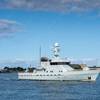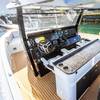A world-first virtual reality simulator for the sub-sea cable installation industry has been developed to offer improved training and reduce the costs and risk inherent in offshore operations. The system has been developed by the Virtual Reality Centre at Teesside for their Darlington-based client CTC Marine Projects. The simulation includes unique virtual replicas of CTC Cable Ships, Cable Ploughs, and ROVs (Remotely Operated Vehicle). The virtual system will interface to a number of third party control systems including A-frame & tow winch control, drum & linear cable engine control and plough and ROV diagnostics/control. The system will be operated on-shore in CTC's state of the art VR-training suite.
The system provides the world's most advanced and comprehensive simulation of cableship operations — taking into account sea-state, ship dynamics, catenery behaviour and soil variations. The system also has the capability to accurately model views of the seabed terrain, facilitating fault diagnosis and analysis.
The project relied heavily on CTC Marine Projects for their experience and on Thales GeoSolutions for the provision of geotechnical data, which allowed accurate modeling of plough behavior. The system fully interfaces to survey systems, Simrad sonar and Kongsberg's APOS system using their own protocols. This ensures that the VR Center software uses actual data for all of its simulated behaviors. The ROV interfaces with SIMRAD Sonar data, TSS - tracking systems, Kongsberg — APOS and SMD's diagnostic launch & recovery systems.
What makes this system so spectacularly different is that all of its simulated functions occur in real-time. That means trainees can control a perfectly engineered, 3-D virtual replica of the plough, ship and ROV systems. They are able to see the virtual systems adjusting and moving just as the real equipment would. The unique system also allows trainees to descend to the virtual seabed to see the effects that their bridge based virtual controls are having on the virtual plough's behavior.
Plans for phase two of the project include a live-link from the virtual system to the real vessels out-at-sea. This will be enormously useful in the event that ship-sonar detects a change in predicted terrain or unexpected soil types along the planned route. The simulator will then be fed live-data from the sea-going vessel allowing on-shore experts to safely try out options before re-laying the best solution back to the crew out at sea. In the event that a plough becomes disabled or damaged, the system can also be used to rehearse recovery before the real-crew make the real-world attempt. Given the high-risk and expensive consequences of mistakes, the simulator blows any cost benefit arguments right out of the water.
The project is due for completion at the end of 2002 and will have taken 18-months to develop, but Tim Dear, the VR Center's Business Development Director, says it has actually accounted for around eight-man years of effort and a considerable amount of ground-breaking software development. The software principles of the system are applicable to a wide range of sub-sea and offshore activities, for example, the fully functional ROV simulator includes umbilical management & collision, cable tracking, propulsion systems, telemetry and manipulator systems and could be adapted to perfectly mimic behaviours of any ROV or AUV.
The client CTC Marine Projects, are delighted with our work and are officially launching the Darlington simulator early in 2003. ''The system enables CTC to rapidly respond to demand in the sub-sea cable sector. Plough pilots do a tremendously difficult job and we have an ongoing requirement to maintain and expand our team of qualified operators'' says Jake Tompkins, CTC's Project Manager for the simulator.
The VR Center, established in 1996, is a University owned company and employs nearly 40 full-time staff. Skills are broadly split between programming for software development and computer modelling for the visualization side of projects. As the name suggests, the Virtual Reality Center specializes in the development of real-time environments.
Featured videos

Inside the Electrified Truckable Tug

Tracking Foreign Vessels Working in the U.S. Jones Act Market

Inmarsat Enhances Service to Drive Digitalization
Subscribe for
Maritime Reporter E-News
Maritime Reporter E-News is the maritime industry's largest circulation and most authoritative ENews Service, delivered to your Email five times per week








